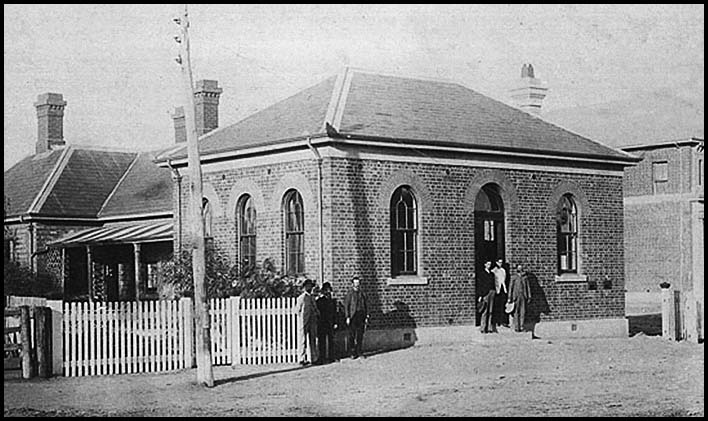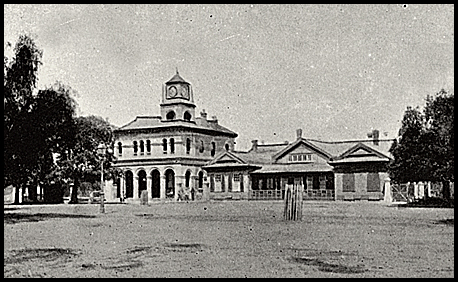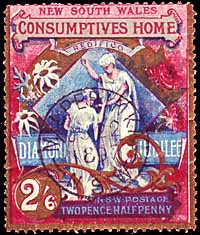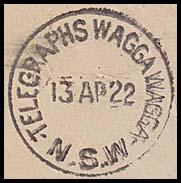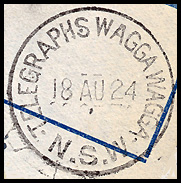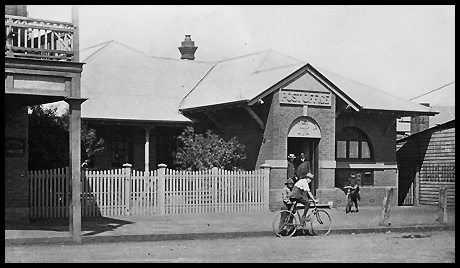Telegraph Offices in the south-west region.
- Home, index, site details
- Australia 1901-1988
- New South Wales
- Overview of NSW
- Telegraph lines
- Telegraph Offices
- Date stamps
- Forms
- Envelopes
- Rates
- Stamps
- Queensland
- Overview of Qld
- Telegraph lines
- Telegraph offices
- Date stamps
- Forms
- Envelopes
- Rates
- Stamps
- South Australia
- Overview of SA
- Telegraph lines
- Telegraph Offices
- Date stamps
- Forms
- Envelopes
- Rates
- Stamps
- Tasmania
- Overview of Tasmania
- General developments
- Reports
- Organisation
- Telegraph lines
- Telegraph Offices
- Date stamps
- Railway lines
- Forms
- Envelopes
- Rates
- Stamps
- Overview of Tasmania
- Victoria
- Overview of Vic.
- Telegraph lines
- Telegraph offices
- Date stamps
- Forms
- Envelopes
- Rates
- Stamps
- Ephemera
- Western Australia
- Overview of WA
- Telegraph lines
- Telegraph Offices
- Date stamps
- Forms
- Envelopes
- Rates
- Stamps
The Yass Telegraph Office was part of the first line to Victoria. Details are therefore included elsewhere.
Telegraph Offices in this region which created the first line to South Australia from New South Wales included Deniliquin, Moulamein, Balranald, Euston and Wentworth.
Public wharves were established by proclamation on 13 April 1872 along the river at Corowa, Mulwala, Tucumwal, Moama, Swan Hill, Euston and Wentworth. These establishments reflect the economic activity which was being generated in the area and so the increased need for telegraphic communications.
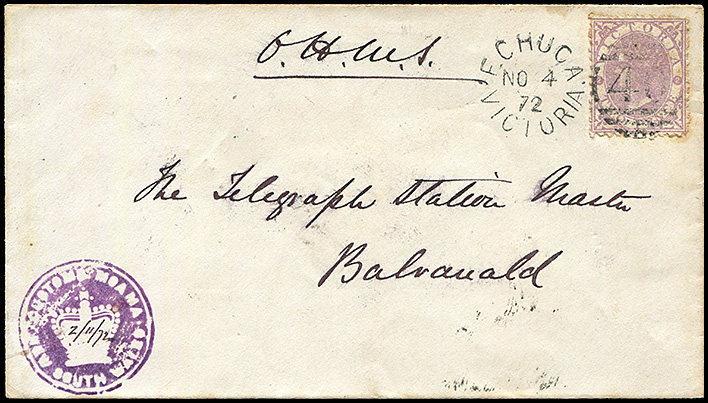 |
Echuca to Balranald 4 November 1872. OHMS cover addressed to the Telegraph Station Master. Has a 2d dull lilac mauve De La Rue design. Cover had crossed the Murray River from Moama to Echuca on 2 November and passed the Customs inspection as shown by the NSW intaglion Crown hand stamp. Very rare. Corinphila May 2018 Lot 3464. |
| Berrigan.
The Telegraph Office opened on 2 November 1891. |
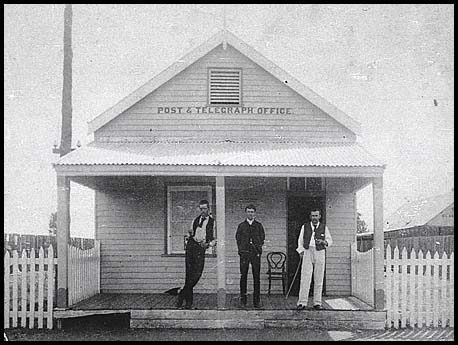 This photo was taken on the day of opening of the new P&T Office or very soon after. |
|
A Post Office opened on 7 March 1861, closed on 30 September 1865 and then reopened on 7 March 1866. The Telegraph Office opened on 1 July 1878 and then combined with the Post Office on 1 November 1878. |
|
| Condobolin.
The Telegraph Office was opened in 1878 and merged with the Post Office on 12 August 1878. The Post Office had been opened on 1 July 1858. Condobolin is the border of the North Central and South West regions but its position along the extension of the Bathurst-Forbes line classifies it as South West for these purposes. Three formats were used for date stamps for the Telegraph Office. |
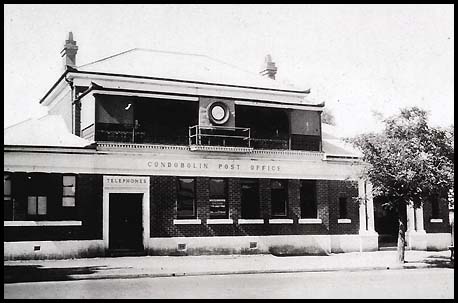 |
|
|
|
|
|
Used on AA-DO-3C. |
|
|
22 August 1980. | |
| Cootamundra.
The Post & Telegraph Office at Cootamundra was opened on 1 July 1877 on which date it changed name from CORAMUNDRA. At that office, a Telegraph Office had been opened on 31 May 1875 and it had combined with the Post Office on 18 December 1876.
|
 |
||
A steel circular TELEGRAPHS COOTAMUNDRA date stamp (SC1 - T) was used for telegraphic related work:
|
| Corowa.
The Telegraph Office opened 21 January 1873 and combined with the Post Office on 1 September 1873. The Post Office had opened on 1 January 1861. Corowa was one of the "border towns" - with Wahgunya - and so had an ambiguous position for the calculation of cost for telegrams. The difficulty was emphasised with rates set for under 15 miles. This ambiguity was not resolved until 1939. |
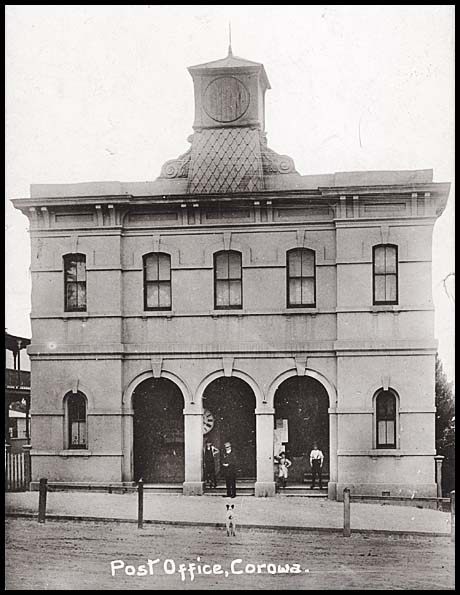 Corowa P&T Office with spire but before clock at top installed. |
||
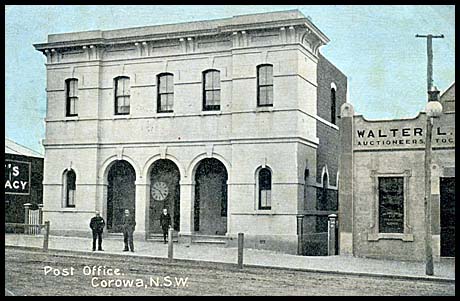 Corowa P&T Office about 1900. Spire not yet constructed. |
| Deniliquin.
The Telegraph Office opened on 1 August 1861 and merged with the Post Office on 1 January 1870. The two offices then separated on 1 August 1875 before recombining again on 29 June 1901. Tenders for called for the erection of a Telegraph and Post Office, Deniliquin in July 1862.
|
 Deniliquin P&T Office taken about 1946. |
A TELEGRAPHS DENILIQUIN date stamp (SC1-T) was used at the Office:
|
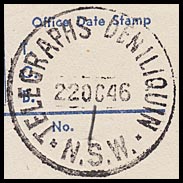 22 October 1946. Used on AW-DO-10 (43). |
| The usual Deniliquin postal date stamp was also used on telegrams. |  16 August 1949. Used on a Telegraphic Money Order |
| Euston.
The Telegraph Office was opened on 26 April 1867. It merged with the Post Office on 1 January 1870. |
| Hay.
The Telegraph Office opened on 7 May 1864 under the supervision of Mr. Middleton. It combined with the Post Office on 23 December 1870. The Post Office had been opened as Lang's Crossing Place on 1 April 1859. The town was renamed Hay in October 1859 and, on 22 February 1861, the Post Office also had a name change. The present Post Office is on the site of the former goal built in 1860. |
||
|
||
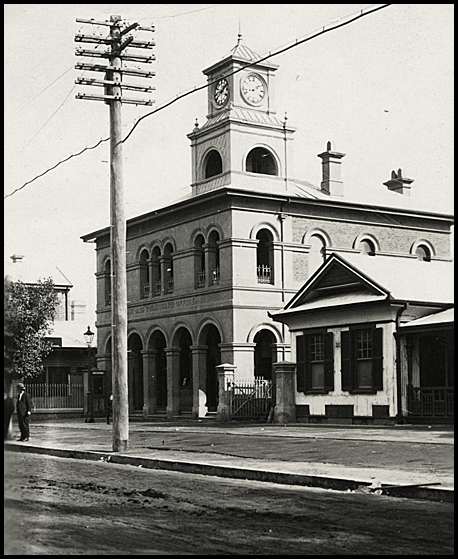 |
(Above): Hay Post & Telegraph Office with the Department of Lands building to the right. |
|
| Even before the telegraph line had been completed, the financial benefits were being anticipated. For example, the Argus of 3 July 1863 carried an advertisement for the sale of the Argyle Hotel which noted, in addition to the facilities, "its close proximity to the Murrumbidgee and to the terminus of the Deniliquin and Hay Telegraph Line renders it a most desirable investment, it being the only hotel in Hay suited to doing a first- class trade".
On 14 September 1872, the Australian Town and Country Journal, in a story about Hay noted:
|
||
| Ivanhoe.
The Telegraph Office opened on 5 February1883 and merged with the Post Office on 15 May 1883. The Post Office had opened on 1 January 1874. |
| Jerilderie.
The Telegraph Office opened on 4 May 1866. It changed name from Jereelderie in 1890. |
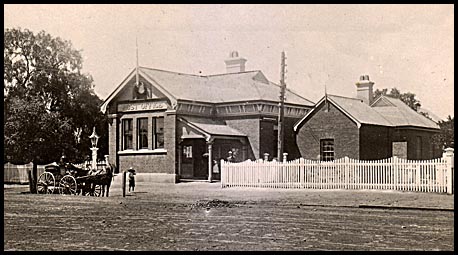 Jerilderie Post & Telegraph Office. |
||
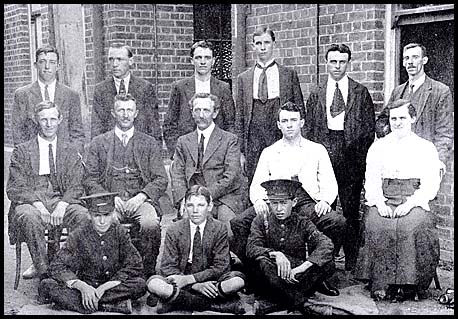 Staff at the Jerilderie Post & Telegraph Office about 1930. |
|
Close to the border with Victoria, a Post Office was opened at Lalalty on the change of name from Naranghi on 1 August 1900. That office was closed on 31 March 1910. On 24 May 1922, a Telegraph/Telephone Office was opened followed later by a Post Office which operated from 1 January 1927 to 1 August 1930. The joint telegraph/telephone office continued to operate until it was destroyed by fire on 13 February 1939. It was closed on 10 March 1941. It then operated until 7 May 1957 as a Rural Automatic (Telephone) Exchange.
|
||
The telegraph section of the joint office was issued with a very unusual date stamp for use with telegrams.
|
 12 April 1939. |
|
| Narrandera.
The Telegraph Office opened at the Post Office on 27 July 1876 and the two offices merged on 1 September 1876. The Post Office had originally opened on 1 October 1861 with a change of name from Gillinbah. The second person to be appointed to the Narrandera P&T Office was the telegraph messenger on 27 November 1878. An excellent history of Narrandera and the surrounding area is given elsewhere. |
||
A rubber circular Telegraph Office date stamp (RC3 - TO) was provided for use with Telegrams.
|
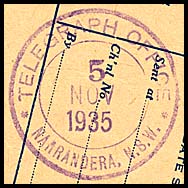 5 November 1935. |
|
|
Tocumwal is just on the border with Victoria. A Telegraph Office operated at the Railway Station from 1 May 1937 to 31 August 1967. |
| Wagga Wagga.
The Telegraph Office was opened on 17 August 1869 as a P&T Office. The Post Office had opened on 1 January 1849. On 29 April 1887, notice was given in the Gazette of the resumption of a portion of land in the parish of South Wagga Wagga, town of Wagga Wagga, in connection with the erection of a Post and Telegraph office. For a reference to the Telegraph Messenger in 1875, see elsewhere. In July 1940, a new Telephone Exchange was opened in Wagga incorporating the most modern telegraphic equipment. From then, telegram messages could be automatically repeated from outlying centres, cities and towns direct to Sydney without having to be repeated by telegraphists.A Telegraph Office was opened as Wagga Wagga Rail Telegraph Office on 20 May 1895. It closed on 31 August 1948. |
 |
 Fitzmaurice Street, Wagga Wagga about 1880. |
| Two formats of a TELEGRAPHS WAGGA WAGGA date stamp were used. | ||
|
Used on an internal memo. |
Used on AB-DO-?. |
|
 17 July 1934. |
|
The usual Wagga Wagga postal date stamp was also used on telegrams. This format changed over the years.
|
Used on NI-DO-1. |
||

